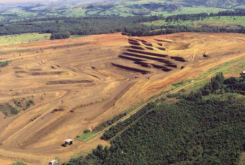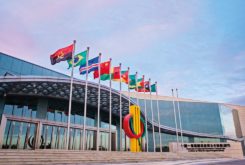The government of Angola has announced that it will finally join the Southern African Development Community (SADC) free trade zone next year. Luanda opted out of the arrangement when it was launched in 2007 and its entry has been delayed several times since then. The zone is designed to promote much greater trade within Southern Africa by removing tariffs and other barriers to trade. As the second biggest economy in SADC after South Africa, the other SADC member states are keen to see Luanda join their numbers.
However, there are still fears in Angola that membership will hinder the growth of the private sector before it has even really got going. Over the past decade, Angolan ministers had repeated the mantra that joining the zone “remained on the government’s agenda” and that the roadmap was still being drawn up, but little real progress was achieved.
The previous Angolan government of José Eduardo dos Santos was reluctant to liberalise trade with the rest of Southern Africa because it feared that it would stymie the development of domestic industries. It argued that it did not want the country to be flooded with cheap imports while it was seeking to build up its own manufacturing base after its long and destructive civil war.
Nevertheless, cheap imports have dominated domestic consumption in recent years, although from China and to some extent Brazil rather than Angola’s neighbours in Southern Africa. This has benefitted Angolan consumers because it has helped to reduce the high cost of many goods but it has undoubtedly had a negative impact on local businesses.
Luanda’s position has shifted under new president João Lourenço, who is keen to diversify the economy away from its long term dependence on hydrocarbons. At present, the Angolan economy relies very heavily on crude oil, liquefied natural gas (LNG) and diamond exports, while importing even many basic foodstuffs. Diversification is even more urgent because the Ministry of Finance predicts that Angolan oil production will fall by a massive 36% between 2017 and 2023, while upstream exploration work is currently very limited.
Angolan Trade Minister Jofre Van-Dúnem Júnio has now revealed that the cabinet has approved its entry into the zone but it is possible that the process could still be delayed because the government has launched a national consultation process to allow people and companies to give their opinions. Tariffs on an estimated 5,000 items have to be removed to enable free trade but they are to be gradually reduced over at least the next decade. It is hoped that this approach will expose Angolan companies to greater competition from their regional rivals more gradually.
Such fears are common in free trade zones, including in the East African Community (EAC), where both Tanzania and Uganda were concerned that Kenya’s larger banking and manufacturing sectors would overwhelm their own nascent industries. Fears of a similar situation in Southern Africa are well founded as South Africa accounts for 68% of intra-SADC exports but just 14.8% of intra-SADC imports.
Angola is vulnerable to greatly increased South African imports but its economy is not well placed to take advantage of the huge SADC market on offer because its own manufacturing and processing sectors are too limited in both size and scope. On the back of its oil exports, Angola accounts for a buoyant 30% of total SADC exports but only 5.8% of intra-SADC exports.
Punitive trade barriers across the African continent have discouraged trade between neighbouring countries, reinforcing the established pattern of African trade, with states exporting raw materials to industrialised countries and importing manufactured goods from them in return. It is generally accepted that encouraging intra-African trade is one of the best methods of promoting higher growth levels and job creation on the continent, yet removing tariff barriers has been a long, drawn out process.
Not completely free trade
Other SADC members have already gone through the process of gradually reducing their tariffs. The SADC Trade Protocol was launched in 2000 and 85% of tariffs had been removed by 2008. Eleven SADC member states joined the free trade zone, with only Angola, Democratic Republic of Congo and Seychelles opting out.
However, member states were allowed to retain tariffs on sensitive products for a few more years. The list of sensitive products included clothing, textiles and leather products. SADC considers that “maximum tariff liberalisation” was achieved in 2012 but this is a little misleading as a few exceptions remain in place. Some tariffs on clothing and textiles remain, in addition to those on car parts, several mineral products and selected foodstuffs. Finally, the reluctance of national governments to lift tariffs seems to be strongest over sugar imports.
In order to qualify for a zero tariff rating, goods must either be manufactured from raw materials or components which have been grown or produced in the exporting SADC country; or have undergone substantial processing within SADC. The latter criterion is the most difficult to assess but minimum levels of processing or reworking for each product are set out by the Community and qualifying products are awarded a SADC certificate of origin by national customs departments. In some cases, products are awarded only partial tariff reduction where the reworking has been more limited.
The Angolan government’s fears could be allayed by the flexibility shown by SADC where there have been specific concerns. While other member states were supposed to remove all internal tariffs by 2012, Mozambique secured an extension that allowed it to retain tariffs on imports from the regional economic superpower, South Africa, until 2015. Luanda may have learned from Maputo’s strategy. It has sought to benefit from Mozambique’s membership of the SADC zone at a ministerial level and a formal cooperation agreement between the two governments was in place between 2013 and 2016.
Tanzania secured the right to retain a 25% import duty on sugar and paper imports until 2015 to give domestic companies time to become competitive with their competitors. Malawi appears to have been the only country to have received support from SADC officials in reducing its tariffs because of its failure to comply with the agreed timetable. However, Zimbabwe was allowed to suspend its tariff reduction programme between 2010 and 2012 when its economic difficulties were at their height.
Continental free trade
Angola’s position is further complicated by the fact that SADC is seeking to create a wider free trade area with the EAC and the Common Market for Eastern and Southern Africa (Comesa), which would encompass 26 countries. They have also set out a timetable for the removal of non-tariff barriers (NTBs), which can include health and safety standards or bribery requests. Exporters are encouraged to report any NTBs they encounter under the SADC Trade Monitoring and Compliance Mechanism.
Further down the line, there is the prospect of the African Continental Free Trade Area (ACFTA) becoming a reality. At a meeting in Kigali in March, at which the COMESA-EAC-SADC Tripartite Free Trade Area Agreement was signed, the governments of 44 countries – including Angola – signed a separate agreement to create a continental free trade zone. The ACFTA would be the world’s biggest free trade zone in terms of population, as there are already more than 1.2 billion people on the continent, although its current GDP of just over $3 billion makes it much smaller than the European Union, which is valued at $18.8 billion.
Outlook
The creation of the free trade zone appears to have had a positive impact. Intra-SADC trade grew from $13.2 billion in 2000 to $34 billion in 2009, while the contribution of intra-SADC trade to total SADC trade grew from 15.7% in 2000 to 18.5% in 2009 and 25% last year. These figures are still low in comparison with internal regional trade in most other parts of the world, so it is reassuring that regional leaders are not satisfied.
In July, Tapiwa Samanga, the SADC secretariat director of industrial development and trade, said: “The SADC region can no longer remain passive in the quest for industrialisation. As a region, we must therefore pursue the objective of industrialising the region with more vigour and focus, taking deliberate forward steps each year.”
Membership of the SADC free trade zone will only be a success for Angola if the government genuinely creates an economic environment within which the domestic private sector can prosper. However, the prospect of being able to target 284 million consumers across the region, including a growing middle class, should prove sufficient incentive for Luanda to join the zone. Apart from anything else, Angola’s manufacturing sector is small enough that the government has relatively little to lose.
Many had expected little change under President Lourenço, with the government and the political elite continuing to dominate the economy. He has, however, sought to reform the economy and promote financial accountability from day one. Only time will tell whether his pledges on governance and economic reform are fulfilled but it is at least promising that he has pledged to put private sector growth at the heart of government policy.
It is important to note that any benefits from the free trade zone will take many years to filter through. It will not tackle the current inflation rate of 24.75% or official unemployment rate of 25%. It can only help as part of a long term strategy to completely rebalance the Angolan economy.
The SADC Free Trade Area aims to encourage:
• Increased domestic production;
• Greater business opportunities;
• Increased regional imports and exports;
• Access to cheaper inputs and consumer goods;
• Greater employment opportunities;
• More foreign direct investment and joint ventures;
• The creation of regional value chains.
It seeks to achieve these goals through liberalising intra-regional trade in goods and services; ensuring efficient production; contributing towards the improvement of the climate for domestic, cross-border and foreign investment; and enhancing the economic development, diversification and industrialisation of the region.



